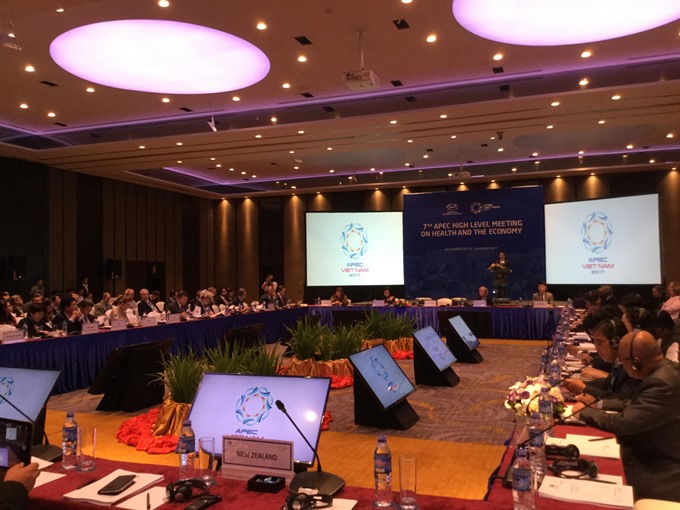 Society
Society

More effective strategies for health financing are needed to improve community health and promote sustainable development in APEC economies, said at the 7th APEC High-Level Meeting on Health & the Economy held yesterday (August 23) in HCM City.
 |
| The APEC High-Level Meeting on Health and the Economy focused on strategies to secure health care financing for community health programmes. —VNS Photo Gia Lộc |
HCM CITY — More effective strategies for health financing are needed to improve community health and promote sustainable development in APEC economies, said senior officials at the 7th APEC High-Level Meeting on Health & the Economy held yesterday in HCM City.
The meeting, held within the framework of APEC’s Senior Officials Meeting (SOM 3), discussed the challenges faced by APEC economies in raising sufficient public revenue for health care and achieving a good rate of return on public investment in health care.
Harnessing public and private innovations to expand access to health care services, and reaching the goals of the Healthy Asia-Pacific 2020 plan, were also part of the meeting’s agenda.
Dr Lokky Wai, representative of the World Health Organisation’s Western Pacific Region, said that finding sufficient resources to support the health sector particularly in human resources was a major challenge, especially in many of APEC’s middle-income economies.
Việt Nam’s Minister of Health Nguyễn Thị Kim Tiến agreed, saying that securing sufficient funds for health was crucial but that it was not the single prerequisite needed for universal health coverage.
“Using available funds efficiently and strategically, arranging appropriate service delivery models, regulating health service quality and safety, and empowering people and communities about health awareness are all needed on the pathway to universal health coverage,” Tiến said.
Also speaking at the meeting, Vũ Đức Đam, Việt Nam’s deputy prime minister, said that occupational diseases as well as non-communicable diseases were “silently affecting society’s health”.
Eighty-two per cent of Việt Nam’s citizens are covered by state health insurance, with 16 million contracts from 40 private insurance companies, Đam said, adding that the government aims to have all citizens covered by health insurance in the near future.
“The government has allocated a large budget to buy health insurance cards for the poor, children and the elderly,” Đam said.
Việt Nam devotes 6.6 per cent of its gross domestic product to health care, according to Đam.
Over the last 20 years, the country has increased public investment in the health sector, reducing individuals’ out-of-pocket spending on health care to 40 per cent from 60 per cent in the past, according to Deputy Minister of Health Phạm Lê Tuấn.
The Ministry of Health aims to reduce the out-of-pocket spending for health care to 30 per cent by raising the number of people covered by health insurance, he added.
Universal health coverage
Matilde Maddaleno, head of Chile’s Ministry of Health’s International Co-operation and Affairs Office, said: “We need to develop better universal health coverage and expand the number of people covered by health care.”
In Chile, 80 per cent of people are covered by public health insurance and the rest by private insurance, she said.
Malaysia’s Deputy Minister of Health Dr. Hilmi Bin Haji Yahaya told Việt Nam News Agency’s television, Vnews, that 23 per cent of the population of Malaysia had health insurance, but that premiums were becoming more expensive.
Malaysia plans to set up a voluntary, nonprofit health insurance scheme managed by the Ministry of Health, he said, adding that payments would be lower and coverage would be more comprehensive.
Professor Ian Wronski of the Division of Tropical Health and Medicine at James Cook University in Australia said that Asia-Pacific countries had done a good job of controlling infectious diseases, but more needed to be done.
“At the same time, the population is getting older and we have to think about how we can provide health services for them,” he said.
Việt Nam’s Deputy Minister of Health Phạm Lê Tuấn told Việt Nam News on the sidelines of the meeting that insurance coverage and access to quality health care services were vitally important.
Late last year, Prime Minister Nguyễn Xuân Phúc approved a new effort to improve grassroots health care by integrating preventive health care and comprehensive primary health care services, thereby reducing costs, especially for people who must travel from their hometowns for care, Tuấn said.
Many people in rural areas in Việt Nam choose to travel to central and city-level hospitals for treatment, adding to their out-of-pocket expenses, he added. —VNS




